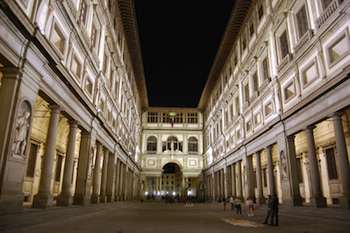- MENU
- HOME
- SEARCH
- WORLD
- MAIN
- AFRICA
- ASIA
- BALKANS
- EUROPE
- LATIN AMERICA
- MIDDLE EAST
- United Kingdom
- United States
- Argentina
- Australia
- Austria
- Benelux
- Brazil
- Canada
- China
- France
- Germany
- Greece
- Hungary
- India
- Indonesia
- Ireland
- Israel
- Italy
- Japan
- Korea
- Mexico
- New Zealand
- Pakistan
- Philippines
- Poland
- Russia
- South Africa
- Spain
- Taiwan
- Turkey
- USA
- BUSINESS
- WEALTH
- STOCKS
- TECH
- HEALTH
- LIFESTYLE
- ENTERTAINMENT
- SPORTS
- RSS
- iHaveNet.com: Travel
By Rick Steves

Florence's Uffizi Gallery
One reason why Italy is so much fun is that it just keeps changing.
Here are a few new developments that are handy for you to know if you'll be visiting the land of "la dolce vita." (I've already covered what's new in Venice and Rome in a previous column.)
Florence still packs them in -- and for good reason.
The Accademia houses Michelangelo's buff, shepherd-boy masterpiece, "David." A few blocks away, the
"The Battle of San Romano" may be out for restoration, but Raphael's "Madonna of the Goldfinch" is finally back on display after a laborious 10-year restoration.
To avoid waiting in very long lines, it's smart to get Uffizi and Accademia reservations in advance. Here are two good ways: through your hotelier (request this service when you book your room) or by phone (from the U.S., dial 011-39-055-294-883). You can book online (www.b-ticket.com/b-ticket/Uffizi), though some of my readers have encountered difficulties using this Website.
If you're in Florence during the off-season (October through March), you can probably get into the Uffizi or Accademia without a reservation in the late afternoon on weekdays. But wise travelers will avoid potential hassles by making a reservation in advance.
Just a few steps away from the Uffizi, Florence's
Milan offers perhaps the most enjoyable look at modern, urban Italy.
Northeastern Italy's rugged yet accessible slice of the Alps -- called the Dolomites -- just got easier to experience. A new, faster cable car dangles above the gateway city of Bolzano to take you to scenic Oberbozen and its Bryce Canyon-like pinnacles.
A free new shuttle bus links my favorite home base in the Dolomites -- Castelrotto -- with the high Alpine meadowland called Alpi di Siusi (which has its own cable car that lifts hikers even higher). To keep cars from marring the landscape, Castelrotto has two new underground parking lots -- one is in front of the bus station.
Italy's Riviera -- at least the five remote villages of the Cinque Terre now protected as a national park -- is more welcoming than ever. While hoteliers in this popular region near Genoa are notorious for artificially bumping up prices, travelers have more negotiating power now, due to the economic downturn. Shop around before you commit to a room. The Cinque Terre Card, which covers a day of hiking in the region's national park, now also includes a free, three-hour bike rental; bikes are available through tourist offices in the towns of Riomaggiore and Vernazza. For many years there was no place to check your luggage, but now you can store bags at the national park's kiosk at Riomaggiore's train station. A new hostel is now open in Corniglia's former schoolhouse, offering bright and clean rooms in the least touristy and most remote of the five towns.
Assisi, the birthplace of St. Francis, is notoriously congested with cars and tour buses, but it just got easier to park your car at the edge of town. The Parking Mojano lot, while below the old town, now comes with an escalator that transports you nearly to the Basilica of St. Clare. It's a blessing.
The Tuscan hill town of Volterra is getting a major tourist transfusion thanks to its connection to the "Twilight" vampire saga. In "The Twilight Saga: New Moon," a crucial scene between the heroine and her undead boyfriend takes place here. (Ironically, the film version used another hill town -- Montepulciano -- to shoot the Volterra scenes.)
Vampires or not, Volterra is still one of the best hill towns in Tuscany. And it just got more user friendly; a group of local guides now offers a low-cost, one-hour walk of the town daily from April to September (www.volterrawalkingtour.com). The tour touches on Volterra's Etruscan, Roman, and medieval history, as well as the contemporary cultural scene -- there's no better way to spend your first hour in this city. Your tween-age daughter will love it.
Italy may have Europe's richest (and craziest) culture. These recent changes make it even easier to enjoy -- and harder to forget.
© Rick Steves Distributed by Tribune Media Services, Inc.
AUTOS | HOBBIES | EDUCATION | FAMILY | FASHION | FOOD & RECIPES | HOME DECOR | RELATIONSHIPS | PARENTING | PETS | TRAVEL | WOMEN
Vacation Travel - What's New in Italy for 2010